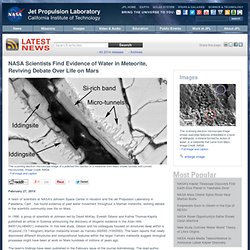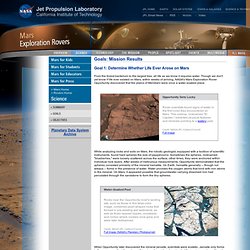

Astrobiology and Space Exploration (Winter 2010) - Download free content from Stanford. Carl Sagan Center. How many planets exists that might support life?

Indeed, what is required for life to exist? How does life start? How does it evolve, and what fabulous creatures can evolution produce? SetiQuest. The Universe in 3D: Planet & Star Size Comparison. Discovery of "Arsenic-bug" Expands Definition of Life. Discovery of "Arsenic-bug" Expands Definition of Life Dec. 2, 2010: NASA-supported researchers have discovered the first known microorganism on Earth able to thrive and reproduce using the toxic chemical arsenic.

New Bacterial Life-Form Discovered in NASA and ESA Spacecraft Clean Rooms. High atop a platform inside a clean room at the European Space Agency’s (ESA) launch site in South America, scientists painstakingly searched for microbes near the Ariane 5 rocket due to launch the Herschel space telescope in May 2009.

Only very unusual organisms can survive the repeated sterilization procedures in clean rooms, not to mention the severe lack of nutrients available. But the scientists’ careful inspection was fruitful, turning up a type of bacteria that had been seen only once before. Two years earlier this same bug had surfaced 4,000 kilometers away in the clean room at NASA’s Kennedy Space Center in Florida where engineers were preparing the Mars lander Phoenix for launch. . * Icy Worlds Projects. The Center for SETI Research. SETI, the Search for Extraterrestrial Intelligence, is an exploratory science that seeks evidence of life in the universe by looking for some signature of its technology.

Our current understanding of life’s origin on Earth suggests that given a suitable environment and sufficient time, life will develop on other planets. Whether evolution will give rise to intelligent, technological civilizations is open to speculation. However, such a civilization could be detected across interstellar distances, and may actually offer our best opportunity for discovering extraterrestrial life in the near future. Finding evidence of other technological civilizations however, requires significant effort. Currently the Center for SETI Research develops signal-processing technology and uses it to search for signals from advanced technological civilizations in our galaxy.
Work at the Center is divided into two areas: Research and Development, and Projects. Titan. Titan is Saturn's largest moon.

It is surrounded by a thick, golden haze, and only certain kinds of telescopes and cameras can see through the haze to the surface. Titan is of great interest to scientists because it has flowing liquids on its surface and a dense, complex atmosphere. 10 Need-To-Know Things About Titan. Europa. Planets:

Calculating the odds of intelligent alien life - Jill Tarter. Visualizing the possibility of intelligent life in the Milky Way. The Drake Equation. "What do we need to know about to discover life in space?

" How can we estimate the number of technological civilizations that might exist among the stars? While working as a radio astronomer at the National Radio Astronomy Observatory in Green Bank, West Virginia, Dr. Frank Drake conceived an approach to bound the terms involved in estimating the number of technological civilizations that may exist in our galaxy. The Drake Equation, as it has become known, was first presented by Drake in 1961 and identifies specific factors thought to play a role in the development of such civilizations.
Although there is no unique solution to this equation, it is a generally accepted tool used by the scientific community to examine these factors.-- Frank Drake, 1961. Big Picture Science. Monday 16 December 2013 We all may prefer the goldilocks zone – not too hot, not too cold.

But most of the universe is bitterly cold. We can learn a lot about it if we’re willing to brave a temperature drop. A chilly Arctic island is the closest thing to Mars-on-Earth for scientists who want to go to the Red Planet. Meanwhile, the ice sheet at the South Pole is ideal for catching neutrinos – ghostly particles that may reveal secrets about the nature of the universe. Comet ISON is comet ice-off after its passage close to the Sun, but it’s still giving us the word on solar system’s earliest years. Also, scientists discover the coldest spot on Earth. Francis Halzen – Physicist, University of Wisconsin-Madison, principal investigator of The IceCube Neutrino Observatory Ted Scambos – Glaciologist, lead scientist, National Snow and Ice Data Center, University of Colorado Pascal Lee – Planetary scientist, SETI Institute, director, NASA Haughton-Mars Project, and co-founder of the Mars Institute.
A needle in countless haystacks: Finding habitable worlds - Ariel Anbar. S Kepler Telescope Discovers First Earth-Size Planet in 'Habitable Zone' Scientists Find Evidence of Water in Meteorite, Reviving Debate Over Life on Mars. This scanning electron microscope image of a polished thin section of a meteorite from Mars shows tunnels and curved microtunnels.

Image Credit: NASA› Full image and caption February 27, 2014 A team of scientists at NASA's Johnson Space Center in Houston and the Jet Propulsion Laboratory in Pasadena, Calif., has found evidence of past water movement throughout a Martian meteorite, reviving debate in the scientific community over life on Mars. In 1996, a group of scientists at Johnson led by David McKay, Everett Gibson and Kathie Thomas-Keprta published an article in Science announcing the discovery of biogenic evidence in the Allan Hills 84001(ALH84001) meteorite.
In this new study, Gibson and his colleagues focused on structures deep within a 30-pound (13.7-kilogram) Martian meteorite known as Yamato 000593 (Y000593). Mars Exploration Rover Mission: Science. Goal 1: Determine Whether Life Ever Arose on Mars From the tiniest bacterium to the largest tree, all life as we know it requires water.

Though we don't yet know if life ever existed on Mars, within weeks of arriving, NASA's Mars Exploration Rover Opportunity discovered that the plains of Meridiani were once a water-soaked place. While analyzing rocks and soils on Mars, the robotic geologist, equipped with a toolbox of scientific instruments, found hard spheres the size of peppercorns. Sometimes the spheres, nicknamed "blueberries," were loosely scattered across the surface; other times, they were anchored within individual rock layers.